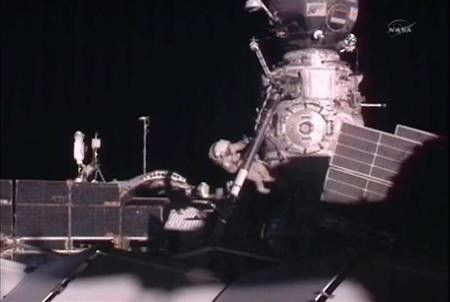Spacewalkers Prepare Russian Module for Dumping

(Reuters) - A pair of Russian cosmonauts floated outside the International Space Station on Thursday to prepare for the removal of a Russian docking module due to be flown into the atmosphere for incineration next year.
Cosmonauts Oleg Kononenko and Anton Shkaplerov worked outside the station during a six-hour, 15-minute outing, the first of three spacewalks scheduled this year.
Their first task was to move one of two 46-foot (14-metre) Stela cargo booms from the outside of Pirs, a Russian docking module that has been part of the $100 billion space station since 2001.
The manually operated cranes are used by spacewalking crews to move equipment around the Russian part of the station.
The station, which flies about 240 miles above the Earth, is jointly owned by the United States, Russia, Europe, Japan and Canada, and is used for medical, materials science, fluid physics and other research in a microgravity environment.
Pirs is expected to be removed from the station in July 2013 to make way for a new Russian multipurpose laboratory module named Nauka which combines docking ports, experiment space, an extra bathroom and a sleeping station for one crewmember.
The spacewalk was broadcast on NASA Television.
Russia's second Stela crane will be relocated during another spacewalk scheduled for August.
Before heading back inside the station, Kononenko and Shkaplerov had planned to install five debris shields to the outside of the command module. The shields are needed to protect the station from micrometeoroid strikes.
Relocating the Strela crane proved more difficult than planned, however, and the cosmonauts ran out of time for the debris shields work. It will be rescheduled for a future spacewalk.
The spacewalkers were able to install a material science experiment and grab some samples of surface residue from the hull of the Zvezda module - one of the station's oldest sections. The samples will be returned to the ground for analysis that will in part determine if the station can safely remain in orbit beyond 2020.
Zvezda, the third of the 14 modules and connecting nodes that comprise the station, was launched in July 2000.
Russia expects to remove the 16.1-foot (4.91-metre) Pirs module from orbit and drive it into the atmosphere over the ocean with a Progress cargo ship a few weeks before the new module is launched.
Most of the 7,900-pound (3,580-kg) Pirs is expected to burn up in the atmosphere. Any surviving debris should fall harmlessly into the ocean.
© Copyright Thomson Reuters {{Year}}. All rights reserved.





















